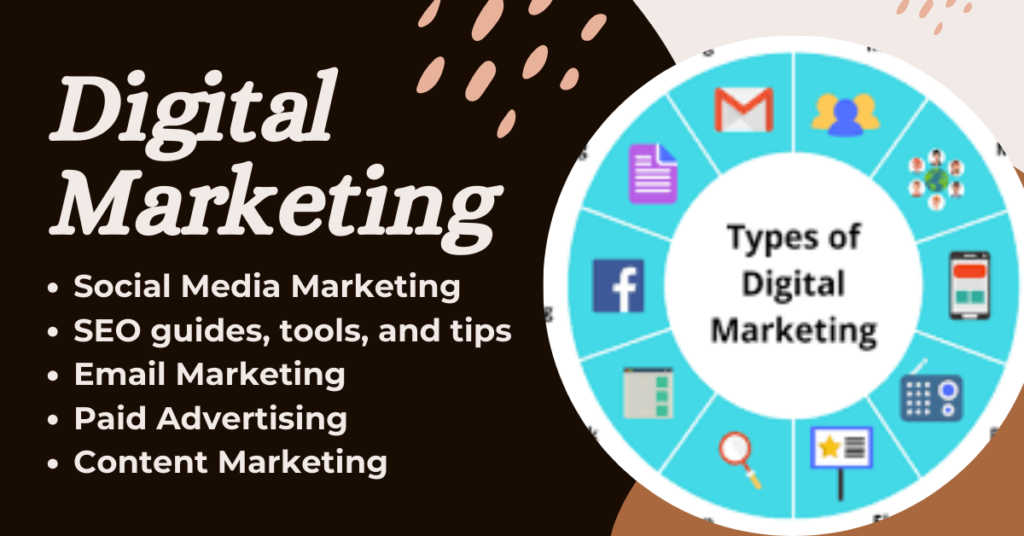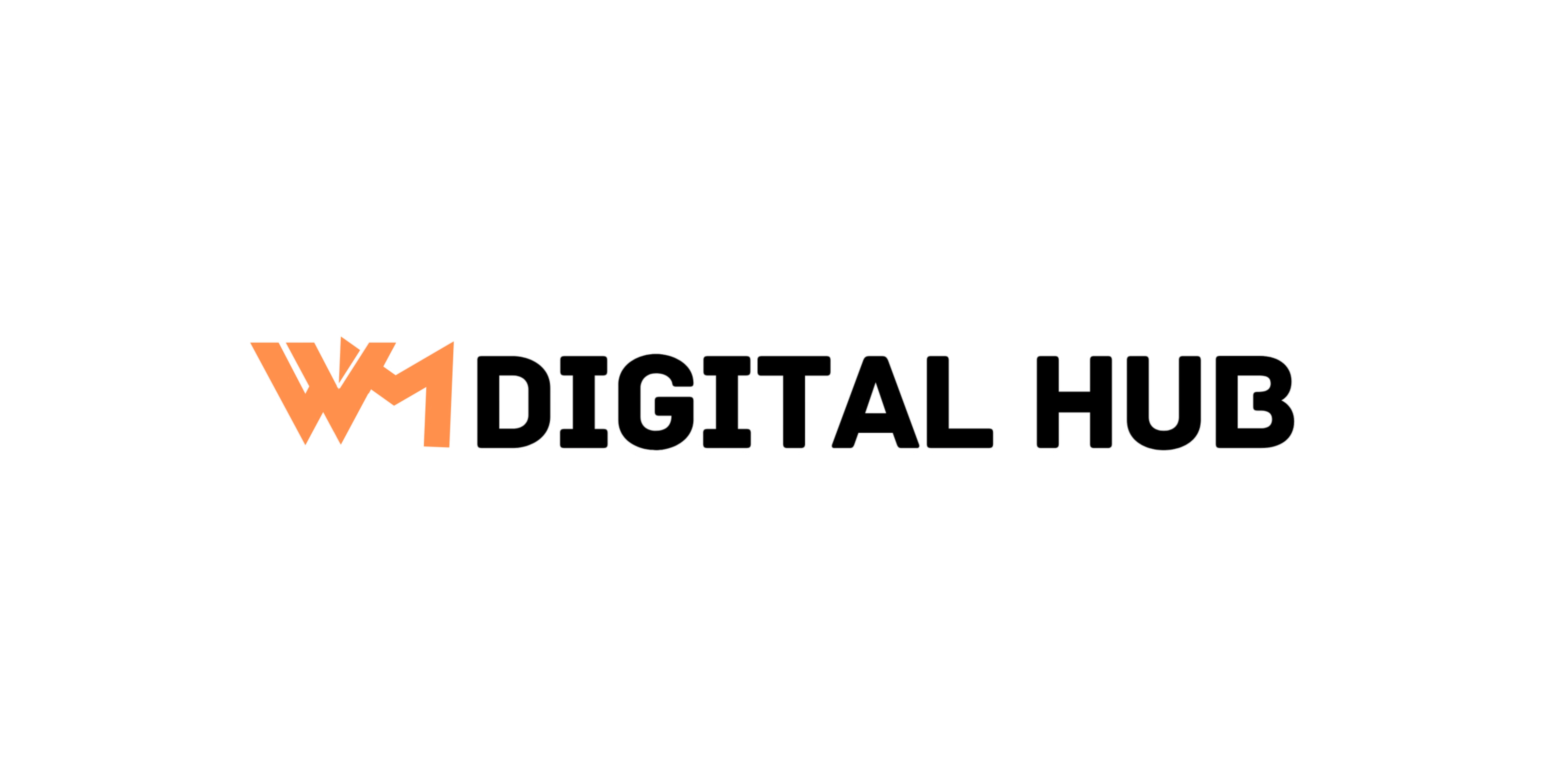
In today’s fast-paced, internet-driven world, digital marketing has become the backbone of every successful business. Whether you’re running a small shop or managing a large company, promoting your products and services online is essential to reach more customers, increase sales, and grow your brand globally.
This beginner-friendly guide will help you understand what digital marketing is, the different types it includes, and how it can transform your business. Let’s dive in!
What is Digital Marketing?
Digital marketing is the art and science of promoting your business online using digital tools and platforms. Think of it as a modern way to connect with your customers where they spend most of their time—on the internet. From search engines like Google to social media platforms like Facebook, Instagram, and YouTube, digital marketing helps you reach your audience directly, engage them, and encourage them to take action.
Example to Understand:
Imagine you own a small bakery. In the past, you might have relied on word-of-mouth or a flyer pinned to a community board. But now, with digital marketing, you can:
- Create a Facebook page to share photos of your cakes.
- Use Instagram stories to show behind-the-scenes baking processes.
- Run a Google Ad so that people searching for “best cakes near me” find your bakery first.
- Send emails to your regular customers with discounts or special offers.
Digital marketing does all this while giving you real-time feedback on what’s working. You can see how many people visited your website, clicked on your ad, or watched your video.
Why It’s Better than Traditional Marketing:
Unlike traditional methods like TV ads or billboards, digital marketing allows you to:
Target Specific People: Reach exactly who you want based on their age, location, or interests.
Stay Flexible: Adjust your strategies in real-time if something isn’t working.
Save Money: Digital campaigns often cost much less than traditional ads.
In simple words, digital marketing is about meeting your customers where they are, understanding their needs, and building a relationship that benefits both your business and your audience.
Why is Digital Marketing Important?
In this digital age, people spend a significant portion of their time online. From shopping to learning, socializing to entertainment—everything is just a click away. For businesses, this presents an incredible opportunity to:
- Expand reach: Connect with a global audience.
- Build relationships: Engage directly with customers through comments, emails, and messages.
- Boost sales: Increase conversions with targeted marketing strategies.
- Track progress: Use analytics to identify what works and improve your campaigns.
Whether you’re new to digital marketing or looking to refine your strategies, understanding its various types is the first step toward success.
Now that you understand the basics, let’s explore the different types of digital marketing and how they can help your business grow .
Popular Types of Digital Marketing
- Social Media Marketing (e.g., Facebook, Instagram, LinkedIn)
- Search Engine Optimization (SEO) (ranking your website higher on Google)
- Email Marketing (sending targeted campaigns)
- Content Marketing (blogs, videos, and infographics to educate and attract customers)
- Paid Advertising (Google Ads, Facebook Ads)
Now that you have an overview of digital marketing, let’s explore its first and most exciting branch: Social Media Marketing!
Social Media Marketing: Your Gateway to Building Connections
What is Social Media Marketing?
Social Media Marketing (SMM) is the use of social media platforms to promote your business, build your brand, and interact with your audience. Whether it’s posting an Instagram story, creating a Facebook ad, or sharing a YouTube video, social media makes it easier to engage your audience and turn them into loyal customers.
Step 1: Understand Your Audience
Ask yourself:
Who are my customers?
Which social platforms do they use the most?
For example, teens might prefer Instagram or TikTok, while professionals are more active on LinkedIn.
Step 2: Choose the Right Platforms
You don’t need to be on every social media site. Focus on platforms where your audience is active. For instance:
Facebook for community engagement and ads
Instagram for visual content and storytelling
LinkedIn for professional networking and B2B marketing
Step 3: Create a Content Plan
Plan your posts in advance. Your content can include:
Informative posts: Tips, guides, or stats related to your industry
Engaging posts: Polls, quizzes, or questions to spark interaction
Promotional posts: Highlight your products/services with clear offers
Step 4: Post Consistently
Consistency builds trust. Whether you post daily or 3 times a week, stick to a schedule.
Step 5: Use Social Media Ads
Want faster results? Invest in ads to target specific demographics, like age, gender, location, and interests. For example:
Run an Instagram ad targeting young travelers for your travel accessories.
Promote your webinar on LinkedIn to reach professionals in your niche.
Benefits of Social Media Marketing
- Build Brand Awareness: People can discover your business more easily.
- Engage with Customers: Respond to their queries and comments directly.
- Increase Website Traffic: Share links to drive visitors to your website.
- Boost Sales: Showcase products with engaging visuals and clickable “Buy Now” buttons.
Recommended Tools for Beginners
- Canva: Design professional posts and ads easily.
- Hootsuite: Schedule your posts and track performance.
- Facebook Ads Manager: Create and monitor Facebook and Instagram ad campaigns.
Example: How to Promote a Small Business on Social Media
Let’s say you run a home bakery. Here’s how you can use social media:
- Post Photos: Share mouthwatering pictures of your cakes on Instagram.
- Run a Contest: Ask followers to tag friends to win a free dessert.
- Collaborate: Partner with a food blogger to promote your bakery.
Final Thoughts
Social Media Marketing is a fun and effective way to connect with your audience, whether you’re starting a new business or promoting an existing one. Start small, experiment with different strategies, and don’t be afraid to invest in tools or ads to see faster results.
Click here to read our detailed guide on Social Media Marketing strategies!
Search Engine Optimization (SEO)
Search Engine Optimization (SEO) is the process of enhancing your website’s visibility on search engines like Google. It’s about understanding what your audience is searching for and ensuring your content appears at the top of their search results. SEO is essential for attracting organic traffic—visitors who find your site without paid ads.
SEO involves:
Keyword Research: Discovering the terms your audience uses. Tools like Google Keyword Planner and Ahrefs can help.
On-Page Optimization: Optimizing content, titles, and meta descriptions to match search queries.
Backlinks: Gaining links from other reputable websites to boost your site’s authority.
For instance, if you’re running a bakery, optimizing for keywords like “best cupcakes near me” or “custom wedding cakes” can drive more local traffic to your website.
SEO is a long-term investment, but the results can be incredibly rewarding. The key is to stay consistent, monitor your performance using tools like Google Analytics, and adapt to changes in search engine algorithms.
Check this post to learn how to master SEO step by step.
- Social Media Marketing (SMM)
Social Media Marketing involves using platforms like Facebook, Instagram, LinkedIn, and TikTok to build your brand, engage with your audience, and promote your products or services. It’s one of the most accessible ways to connect with customers in real-time.
A strong social media strategy includes:
Content Creation: Use tools like Canva to design visually appealing posts.
Audience Engagement: Respond to comments, messages, and reviews promptly.
Paid Campaigns: Platforms like Facebook Ads Manager allow you to run targeted ads based on demographics, interests, and behaviors.
Consistency is crucial. Posting regularly and maintaining a unified brand voice can significantly improve your reach and impact. For example, a fitness coach can share workout tips on Instagram Reels or a law firm can publish industry insights on LinkedIn.
Want to create a winning social media strategy? Check this post for detailed tips.
- Content Marketing
Content Marketing is about creating and sharing valuable content that informs, educates, or entertains your audience. It’s not about direct selling; it’s about building trust and authority in your niche.
Content marketing can take many forms, including blog posts, videos, infographics, podcasts, and eBooks. Tools like Grammarly help ensure error-free writing, while platforms like BuzzSumo can inspire trending content ideas.
For example, if you run a travel agency, you could write a blog titled “10 Budget-Friendly Destinations for 2024” or create a YouTube video showcasing travel hacks. Content like this can attract potential customers and subtly encourage them to explore your services.
Remember, quality always beats quantity. Focus on creating content that genuinely adds value to your audience’s lives.
Check this post for expert tips on crafting impactful content.
- Email Marketing
Email Marketing remains one of the most effective ways to nurture leads and drive sales. By sending personalized emails to your subscribers, you can keep them informed about your latest offers, updates, and events.
A successful email marketing strategy includes:
Segmenting Your List: Grouping your audience based on their interests or behavior. For example, offering exclusive deals on kids’ clothing to parents.
Automating Campaigns: Use tools like Mailchimp or ConvertKit to schedule and manage your emails.
Analyzing Results: Track open rates, click-through rates, and conversions to optimize your campaigns.
For instance, an online bookstore can send a monthly newsletter recommending new releases or bestsellers, encouraging readers to visit their website.
Read this post to dive deeper into email marketing strategies.
- Pay-Per-Click Advertising (PPC)
PPC advertising allows businesses to display ads on search engines, social media, or websites and pay only when someone clicks on them. It’s a quick way to drive traffic and generate leads, especially for new businesses.
Key elements of a PPC campaign include:
Keyword Targeting: Choosing the right keywords for your audience.
Ad Copy: Writing compelling headlines and descriptions.
Landing Pages: Creating user-friendly pages that convert clicks into customers.
For example, a boutique can run a Google ad targeting the phrase “affordable summer dresses” to attract shoppers looking for seasonal fashion. Tools like Google Ads and SpyFu can help refine your campaigns for maximum ROI.
Check this post for a beginner’s guide to running successful PPC ads.
- Affiliate Marketing
Affiliate Marketing involves partnering with affiliates who promote your products or services in exchange for a commission. It’s a win-win strategy where you pay only when you make a sale.
This type of marketing is especially effective for e-commerce brands or online courses. By working with bloggers, influencers, or website owners who have a loyal audience, you can expand your reach and boost sales.
For instance, a fitness brand can collaborate with a health blogger who writes a review of their protein powders, including an affiliate link. Tools like Fiverr Affiliates, ShareASale, and Amazon Associates are great for finding affiliate partners.
Discover how to succeed in affiliate marketing in this post.
Final Thoughts
Digital marketing offers endless possibilities, but success lies in choosing the right strategy for your business and audience. Whether you’re optimizing for search engines, running a social media campaign, or creating valuable content, each type of digital marketing has its unique benefits.
Start small, track your progress, and don’t be afraid to experiment. With the right tools and dedication, you’ll see your efforts pay off.
Want to learn more about each type of digital marketing? Check out our detailed guides for actionable insights and expert tips. Start your journey today!



